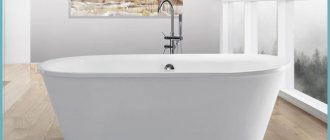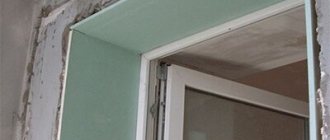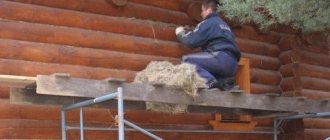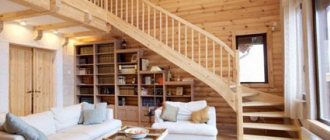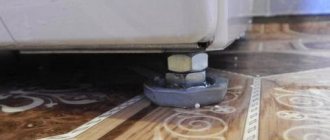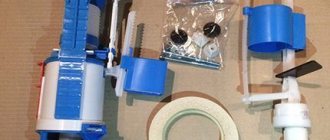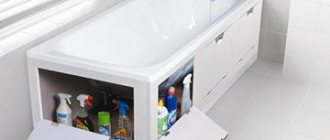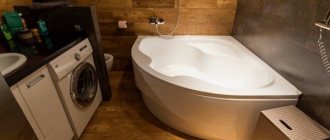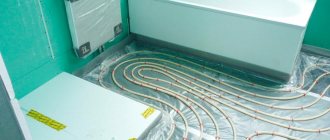Even the most stylish bathroom interior will look ridiculous if the space under the plumbing fixture is not covered. You can decorate it using different methods, but installing a screen is considered the best and most reliable. With it, you can not only improve the room, but also create a comfortable work area, hidden from prying eyes. Under such panels in the free space you can place household chemicals, small buckets and other things.
How to select a screen
A bath screen is a rigid structure made of a frame and hinged, sliding or blind (tightly fixed) panels. They are installed on the outside of the bathtub (with the exception of a free-standing bowl, where decorative protection is installed around the perimeter). There is a huge selection of protective screens on sale based on frame and panel materials, design and design features. Therefore, choosing a beautiful, easy-to-install product without preparation is difficult. We fill the gap and note the parameters that you should pay close attention to when purchasing a screen:
- functionality - how important is free space under and around the bathtub for the housewife: it will be used to store household chemicals, leftover building materials, etc. or the screen will serve as a screen hiding plumbing communications;
- complexity of installation. Here you need to consider two points: is it possible to do the work yourself; Is it possible to install the type of screen you like on an acrylic bathtub?
- cost of the product - for many families this criterion is very important, because the price of a factory screen can range from 300 to tens of thousands of rubles;
- durability - ideally, the service life of the screen should coincide with the service life of the bathtub;
- dimensions - determine the dimensions of the set for the installed bowl;
- appearance - depends on the aesthetic preferences of the owners.
Functionality
Installing a screen on a corner acrylic bath solves several problems at the same time:
- hides water pipes, siphon, frame and walls of the bathtub;
- completes the interior design of the bathroom;
- creates a closed space for storing household chemicals and care items for acrylic and plumbing fixtures of the room.
You can buy screens for specific tasks:
- with sliding doors - a classic of the genre, the easiest to install, practical and easy-to-use option. Performs simultaneously all the tasks assigned to this element of acrylic bowl arrangement;
- swing - an improved type (replica) of a sliding structure. Instead of doors, doors are attached to it. But such a screen can only be installed in a spacious room - you need space to open the doors;
- deaf. The consumer immediately has a question: how to maintain plumbing equipment in this case? The answer is simple: blind versions of decorative panels are removable, attached with magnets (available for bathtubs of original shapes and sold together with the bowl) and stationary with a hidden hatch for access to the siphon. This type of decoration of the walls of the font is characterized by simple installation, increased strength and high aesthetics (designers claim that a solid surface looks more attractive than one divided into sections or doors). But it will not be possible to store any objects or things behind such decor.
Sometimes you can find sliding curtains made of film or fabric instead of screens. They perform the same functions, but it is difficult to classify them as screens. This is most likely a decorative element in the design of the font bowl.
Difficulty of installation
The most difficult way to attach a screen to an acrylic bathtub with hinged doors. But this is in comparison with a blank panel. If we evaluate the technology as a whole, then any representative of the human race who has ever worked with a screwdriver can install a screen of any type - there are no difficulties in the instructions.
Price
The difference in screen prices is significant. Plastic models can be bought for 300-700 rubles, from MDF for 4,500-8,500 rubles, and from cast acrylic for 30,000-45,000 rubles.
Durability
The service life of the protective panel is influenced by the type of materials from which the frame with fasteners, fittings and sashes (doors) are made.
Manufacturers offer the frame in several versions:
- made of plastic;
- become;
- aluminum
The plastic frame is the cheapest, with a sufficient level of strength for gentle operation. But the strength laid down by the manufacturer is not able to withstand an accidental kick on the rack - it crumbles, without the possibility of restoring the structure.
The steel parts of the frame cost about 3 times more than their aluminum counterparts, but they will also last longer, because... In practice, cases of deformation of aluminum screen elements are observed. Fittings can be made of plastic, brass, aluminum and steel. The most durable handles are made of galvanized steel. Brass and aluminum are prone to corrosion in humid conditions.
Plastic by its nature does not last long. The problem most often occurs in painting - peeling.
The screen doors can be:
- made of plastic - they can serve for a very long time, but having increased fragility, they are easily damaged by mechanical stress;
- plexiglass (plexiglass). The material has the same problem as plastic - high fragility;
- MDF is the most suitable option in terms of service life;
- cast acrylic - corresponds to the service life of the bowl;
- Tempered glass is expensive, but will last a long time.
Size
Most often, a protective plastic panel coated with a thin layer of acrylates is also sold along with an acrylic bathtub. This allows you to get a screen that is perfectly sized to the font and has a tone that matches the sanitary ware. This approach is especially relevant when buying a bowl of an original shape - it is unlikely that you will be able to select a screen. But such panels are sold only in a solid version, which many housewives do not like - there is no way to hide small household items that are used in the bathroom. Therefore, most often the screen is purchased separately or installed independently from scrap materials.
If the panel with the frame is not purchased as a set, then before going to the retail outlet, the length of the bowl and its height above the floor level are carefully measured. If the exact dimensions of the screen are not on sale, you need to buy with a small margin - the excess length can always be cut off with a grinder, and the height can be adjusted using the legs of both the bowl itself and the frame under the panel.
Design
Screen doors (doors) can be made from several types of materials:
- plastic. Such screens can have a variety of textures and colors, as a result of which choosing a screen to suit the interior of a particular room will not be difficult. But the design as a whole looks in accordance with the price - not rich;
- plexiglass. Matte or mirror surfaces look very impressive, giving the room a special charm. But installing such a screen without a thoughtful design of the entire room sometimes leads to dissonance in the interior;
- MDF panels. Looks expensive, stylish, fits perfectly into any interior;
- cast acrylic Used for round or asymmetrical bathtubs (sold together with the bathtub, as it is impossible to choose). You will have to pay a decent amount for such a panel, but it is worth it - it looks great, creating a single whole with the bowl.
When making a screen yourself, the panel can be made of plasterboard, painted with water-based paint, boards or ceramic tiles (glued to gypsum board).
What you will need for installation
Typical factory screens are mounted using the spacer method, resting the horizontal section of the frame under the side, and on the opposite side from below, unscrewing the support posts with some force.
Even a woman or a schoolchild can install a standard factory-made screen under a bathtub; this does not require expensive construction tools. Some manufacturers complete their products with a flat key for tightening the legs.
A flat or adjustable wrench may be needed when installing a standard or sliding screen to adjust its height using the lower supports.
The screen frame in the vast majority of cases is made of aluminum coated with polymer coating in various colors. To install a screen under a bathtub of standard length, it is cut on one side for an exact fit. To perform cutting work on aluminum guides, you will need a hacksaw. It can also be useful if the height of the screen is too high and does not allow it to be installed under the bath. In this case, the protruding sections of the vertical posts into which the supports are screwed are cut off.
Wooden fences
In many cases, next to the bathroom there is a sink, the pipes from which go under the bowl to the sewer pipe. In this case, you will have to cut the side panel where the pipeline passes. Depending on the type of material used to make the panels, this can be done with a fine-toothed metal hacksaw or a paint knife.
When placing a screen of complex shape under acrylic baths, it may be unevenly immersed under the side along the entire length. To level it, scraps of wooden beams or rigid extruded foam are usually glued, placing them at the same distance from the lower edge of the side. To carry out operations, in addition to fragments of supporting materials, you will need appropriate glue for polymer materials (acrylic).
In order to correctly install a sliding plastic screen under the bathtub, it is necessary to maintain the vertical position of its location under the side. To track the position, you will need a short building level, which is also necessary when installing the bowl itself.
Factory screen barriers made of MDF
Materials and tools
Before starting work on installing the factory panel, you need to buy the screen itself and select a set of tools (buy, rent, borrow from friends or neighbors).
The kit should include:
- sashes - 2-3 pcs.;
- frame consisting of 2 (preferably 3) vertical posts and 2 horizontal ones;
- legs;
- pens;
- screws for fastening handles (2 per handle);
- self-tapping screws for attaching the frame to the bowl.
Attention: manufacturers increasingly began to supplement kits with screwdrivers for screws and self-tapping screws, and wrenches for legs, and therefore they will be superfluous in the tool kit.
Tools you will need:
- screwdriver with drill and bits: slotted and cross-shaped. The tool will be needed for drilling holes for handles, and also as a replacement for screwdrivers;
- roulette;
- construction pencil or marker;
- level;
- wrench, if not included;
- silicone sealant.
Useful tips
The following advice from experts may be helpful when selecting a suitable screen fence and its installation:
- One of the varieties of screen fencing - with PVC panels, is one of the most budget types with a cost of 500 rubles. These are universal screens, that is, if they are larger in height, you can shorten the vertical posts and trim the panels at the top. For large length sizes, simply shorten the horizontal guides on one side.
- In any collapsible frame, vertical slats are sometimes located in inconvenient areas. They can be unscrewed and moved to another location by first drilling holes at the desired points on the profile guides.
- Expensive MDF screens with an average cost of 4,500 rubles. have higher strength characteristics in contrast to plastic ones. Laminated panels cannot be cut in height if the screen is larger than the space under the bathtub, so it is advisable to purchase it after installing the bathtub.
Installation instructions for a standard screen
- When purchasing, it is more practical to choose panels with cut holes instead of overhead handles. They are more reliable in operation, do not protrude beyond the plane of the panel and serve as a hatch for ventilating the enclosed space under the bathroom.
- To prevent water from getting on the frame and canvas, leading to the formation of mold and loss of their aesthetic appearance, the gap under the side of the bathtub is sealed with silicone sealant.
- The lower gap in the screen under the bathtub, although convenient for placing feet, spoils the aesthetic appearance of the room, so the screen fence is selected as accurately as possible in height. If desired, you can set the bathtub itself to the height of the already purchased fence.
- If the user is very bothered or does not like the two side stands, proceed as follows. Remove one of the vertical strips, installing the second in the middle. The corners are screwed to the ends of the lower horizontal profile. Make marks on the cladding along the holes in the corners, drill through the wall with a hammer drill and insert dowels. The side corners connected to the lower horizontal guide are screwed through the dowels with self-tapping screws, securing them to the walls.
Cost of plastic and MDF models
To install a sliding plastic screen under a bathtub with your own hands, you need a simple tool for cutting metal, with which you can adjust the horizontal aluminum guides to size. Basically, installing a standard screen barrier does not cause any particular difficulties; the vertical position of its position is checked by the level or seams of the tiles on the side walls, and increased attention is paid to the accuracy of cutting panels for pipes.
How to quickly remove the screen without damaging it
It is almost impossible for an untrained home craftsman to remove the screen from an acrylic bathtub without damaging the panel. You need to know the type of fastening. However, not everything is so complicated in the end if you know some of the nuances.
- If there are no supports between the bottom of the screen and the floor, then the panel is secured in one of three ways: self-tapping screws, magnets or using springs.
- The supporting legs of the screen frame indicate that it is installed sideways.
- Direct fastening of the panel to the floor indicates the presence of spring clips.
With this information, you can easily remove the screen.
Fastening with self-tapping screws. The panel hanging above the floor should first be inspected for the presence of plugs. If they exist, then the problem is solved in two steps:
- decorative plugs are carefully removed using a sharp blade;
- Use a screwdriver to unscrew the screws.
Magnets. If there are no plugs, the panel quietly pulls down. If a little effort is not enough to tear the screen out of place, it means it has magnets on the bottom and latches on top. It's easy to remove - just pull the top towards you. In this case, it is advisable to perform the operation with several hands, so as not to distort the screen too much.
Springs. Pull the panel down and out from under the side. After this, disconnect the springs from the hooks.
Attention: if there are no plugs, and attempts to remove the panel by other methods were unsuccessful, it means that the screen is still on screws, and the heads of the hardware are skillfully masked with sealant by a good craftsman. In this case, a needle will help - in the supposed locations of the screws you need to carefully prick the acrylic (plastic). Acrylic (plastic) will resist, but the sealant will puncture easily. Then it’s simple: the homemade plug is removed, the hardware is unscrewed.
Installation by surprise. The presence of a frame is indicated by the legs. In such options, the screen is attached to the acrylic bathtub by surprise. To remove the panel, simply screw the legs into the frame and then pull them towards you.
Spring latches. The panel is removed from the spring clips in two steps:
- the upper edge of the panel is pulled towards itself until the clamps are released;
- the screen is raised up to release the latch tab from the clamp attached to the floor.
Breakage Prevention
To avoid repairing a damaged bathtub, you should pay close attention to signs of possible problems.
- If sagging occurs in the acrylic bathtub, you can place blocks or other stable objects under its base. This solution will help those whose plumbing is covered with a screen. This method will significantly reduce the pressure on the inside of the bathtub and prevent cracks from forming.
- Creaks when using the bathtub indicate that the plumbing fixtures were installed incorrectly. This may also be caused by the walls and bottom of the product being too thin. But this problem is also being solved.
- You should carefully look at the purchased bathtub in sunlight. The product should not be transparent. If gaps are noticeable, you can use latex paint, which is applied in bulk to the surface of the bathtub. This will help increase the strength of the plumbing and prevent many defects from occurring.
Many people are interested in how long restored plumbing fixtures will last?
Having found out the reasons and methods for repairing an acrylic bathtub, you can independently eliminate various damage to the plumbing. Repairing products of low complexity can be carried out without assistance, but in the event of a serious breakdown, you should trust the specialists. You can update your bathtub with acrylic, which will be an excellent way to restore it. It should be remembered that polymer baths can be restored in case of any damage. Therefore, it is better not to throw away your old acrylic bathtub, because repairs will allow it to last for a few more years.
Watch this video on YouTube
Sources
- https://vanna-prosto.ru/santexnika-dlya-vannoj/remont-akrilovyx-vann/
- https://vannayaa.ru/vybor-vann/restavratsiya-vannoj.html
- https://stroitelniportal.ru/svoimi-rukami/remont-vannoj-komnaty/pokrytie-vanny-akrilom/
- https://vanna-expert.ru/santekhnika/remkomplekt-dlya-akrilovykh-vann.html
- https://SdelaySam-SvoimiRukami.ru/4472-restavraciya-vanny-zhidkim-akrilom-svoimi-rukami.html
- https://sovety-vannoy.ru/vanna/akrilovaya/remont-akrilovyx-vann-v-domashnix-usloviyax.html
What and how can you make a screen with your own hands?
You can make a screen with your own hands. The technology is simple:
- The bathtub is being tied up. The material can be brick, wooden beam, metal profile. At the same time, any of the above materials are suitable for rectangular bowls; for semicircular corner baths, brick and a special aluminum profile (it can be given any rounding). During the work, it is important not to forget to make a harness under the hidden hatch through which the bathtub siphon will be serviced;
- You can immediately attach ceramic tiles to the brick, and cut-to-size sheets of gypsum plasterboard are screwed onto the frame with self-tapping screws;
- a finishing finish is applied to the drywall (mostly ceramic tiles).
In conclusion, choosing the right screen will make the task easier: no need to adjust anything, just install. The instructions for all types of fastenings are simple and easy to follow on your own.
Cons of acrylic bathtubs
Strength. As mentioned above, the weight of an acrylic bathtub is both an advantage and a disadvantage of the product.
Strengthening the bathtub so that it does not wobble is the main task during installation. The low level of resistance to mechanical stress requires increased precautions when using the product. A chip, crack, or dent can form even as a result of falling a heavy object. Coating
The surface of acrylic bathtubs is vulnerable to some chemicals. Also, acrylic should never be cleaned with abrasives. Sensitivity to high temperatures. The temperature limits for an acrylic bathtub at its highest point do not even reach +60 degrees. Boiling water causes deformation and cracking of the covering top layer.
Bathtub repair with acrylic liner
The process of restoring equipment by inserting an acrylic liner into it, which is called “bath in bath,” is essentially a complete repair of an old product. Installation of an acrylic liner is carried out with a special mounting compound that has heat-insulating properties.
The essence of the restoration process is to put an acrylic insert on an old bathtub, which is very similar to putting a lid on a jar. Installation of the liner lasts about 2 hours, and then the updated product must dry for 24 hours. During this time, it cannot be used.
Upon completion of the work, they receive a completely new coating, which is also 3 times cheaper than a new bathtub made of this material. The price of restoration ranges from 6,700 rubles. up to 8000 rub.
Performance characteristics of acrylic liner
Inserts for bath products are made in the factory from modern generation polymers. This is exactly what sanitary acrylic is when combined with ABS plastic. The excellent appearance of the material and the absence of micropores in its structure are decisive for the positive performance properties of acrylic liners:
- flat, smooth surface of the insert, free of pores and depressions;
- the ability to maintain water temperature for a long time (cooling will occur more slowly than before installing the liner);
- resistance to loads (greater than for a conventional acrylic bathtub, since the old product serves as a frame for the insert);
- noise-absorbing properties.
However, it should be noted that after installing the liner in the bathtub, its size will decrease by two centimeters on each side. But the new coating has antibacterial properties and dirt can be easily washed off with ordinary soap.

